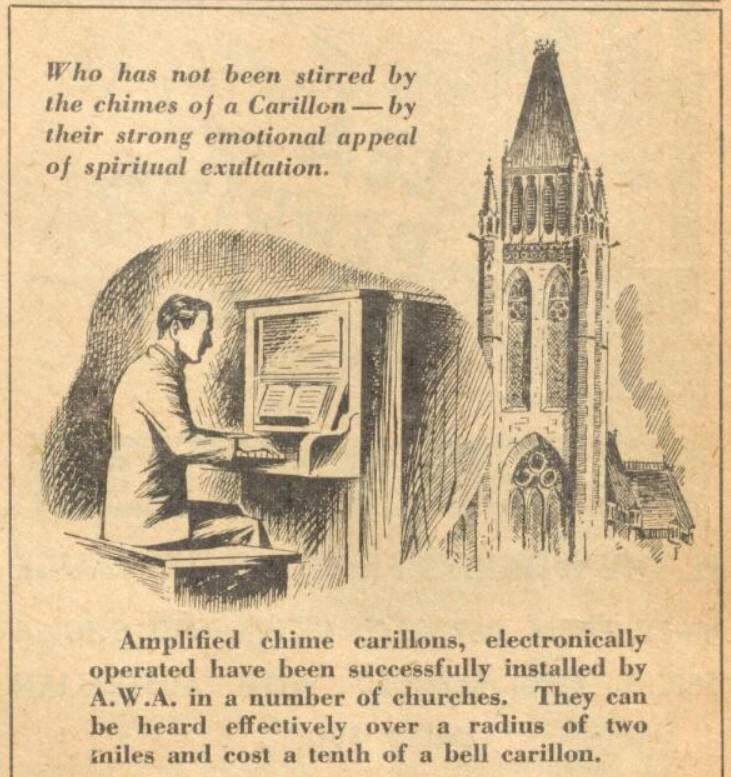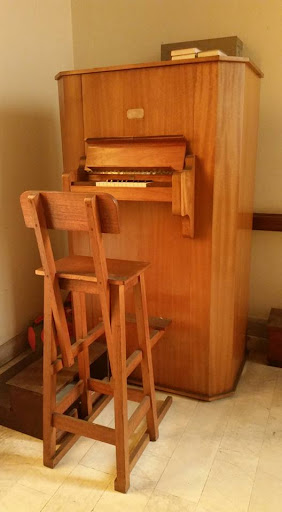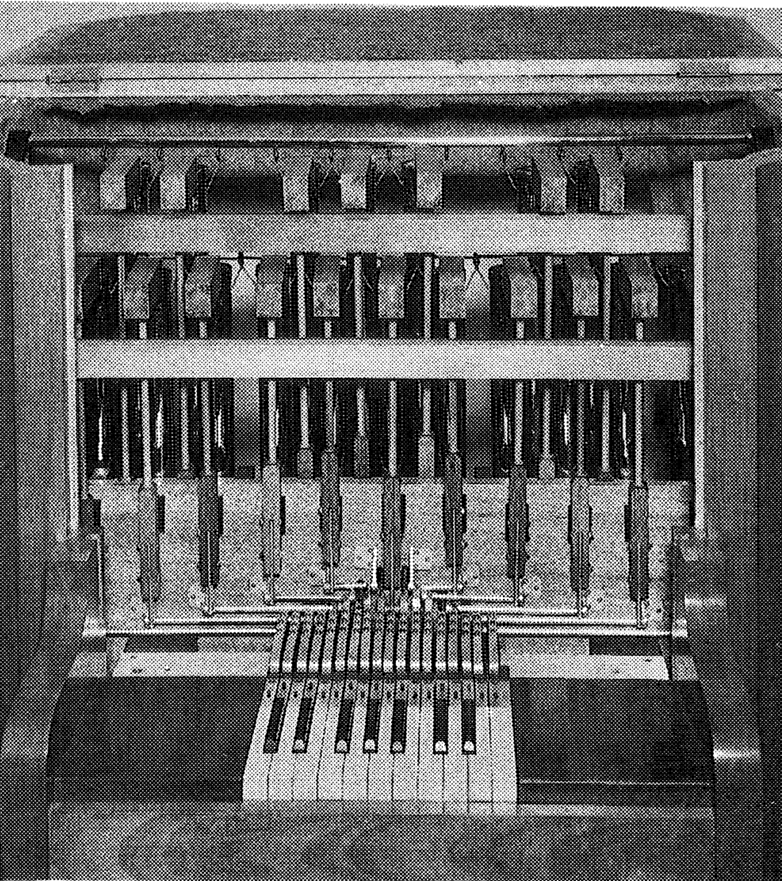Introduction
I'll admit to being a bit
surprised when I first heard that Australian electronics company A.W.A.
(Amalgamated Wireless Australasia) used to manufacture "carillons".
I'd toured the AWA factory back in the 1960's and I don't remember
seeing any bells! A.W.A made radios and later TVs. What would they know about
carillons?
This ad gives us the
clue....

Aha! "Amplified Chime
Carillons". But what are they? Fortunately, a search of the
National Library's Trove database yields us some more information....
A Description Of The Carillon
(taken from the Singleton Argus, Friday 31 October,
1947)
The A.W.A. electronic tubular bell
carillon is an instrument entirely new in design and in
itself a complete reproducing unit for the change music
so dear to the hearts of all English from the music
written for the people of the low countries of Europe
and others of ancient law.
The instrument is independent of any type of recording,
as is so often used as an inferior substitute for this
type of music.
The carillon was developed to its present high standard
in the laboratories of A.W.A. by its own technicians and
engineers to break the long silence of so many of our
beautiful churches.
A complete set of bells with the same musical range
would be practically unprocurable to-day, and in many
instances prohibitive, because of the high cost
originally and in the cost of installation, even if a
belfry or tower of suitable mechanical strength was
available to house them.
The instrument also, like others of its type, does not
interfere in any way with the existing organ and allows
players to fully express themselves as to their
interpretation of music by light and shade, because soft
and light striking of the keys has been made possible.
Softer reproduction than by the bell types has been made
possible.
Sounds are sent out by high powered amplifiers.
SCOPE PRACTICALLY UNLIMITED
Half notes are included in the range of one and a half
octaves (C to F') which enable practically any piece of
music to be faithfully reproduced. This factor is one of
the utmost importance.
Scope of tunes which can be played on the carillon is
practically unlimited.
When an electric carillon recital was given a short time
ago in Sydney by Mr. Philip G. Woods, organist at St.
Anne's Church, Ryde, he played the following items:
English Change Bells (Grandsire Peal in Eight Bells;
Steadman's Plain Course).
Jesu, Joy of Man's Desiring (Bach).
Silent-Night, Ring Out, O Bells, Rule Britannia,
John Peel, Ashgrove, White Wings, Land of Hope and
Glory.
Killarney, When Irish Eyes are Smiling, The Minstrel
Boy, Believe Me If All Those Endearing Young Charms.
Blue Bells of Scotland, The Bonnie Banks of Loch Ye
Banks and Braes.
Silent Worship (Handel), Beautiful Isle of
Somewhere, Carillon, Austrian Duke Street, Auld Lang
Syne and the National Anthem.
The solid maple console protects the bells and damage is
impossible. This was designed and build by Mr. Noad, who
needs no introduction to the organ enthusiasts of this
country.
Simplicity of the console has made the installation
problem a simple one.
No musical knowledge is essential in the
playing of the carillon, and it has been played on
several occasions by young people who could not play a
piano or organ.
Any person who can pick out a tune with one finger can
successfully play the A.W.A. carillon.
How very different this is to the old methods and hours
of strenuous practice needed to take even a small part
in bell-ringing by professional methods!
On sharply depressing a key, which takes little more
effort than a piano, a simply-balanced hammer carries
forward and strikes a tubular bell, and loudness is
dependant entirely on the force expended in depressing
the key. The hammer then recedes, leaving the bell free
to ring in its true tone.
When the key is allowed to rise, a soft felt damper is
automatically applied to a scientifically predetermined
part on the bell to eliminate the sustained ringing that
has so often been raised as an objection in this type or
even with a fully rung carillon, or even a ring of
bells.
Thus, clear, true ringing is produced through
high-powered amplifiers, which can be controlled
according to the topography of the surrounding district.
The supervisor of installation IS A SINGLETON NATIVE
The man who was in charge of the installation of the
carillon is a native of Singleton, so that the advent of
such a church innovation has more than ordinary
significance.
That man is Mr. Lan Clark-Duff, of Roseyille, a member
of the technical staff of A.W.A.
He was born at Singleton, where his father, the Rev.
Victor Clark-Duff was Presbyterian Minister for a number
of years.
Mr. Lan Clark-Duff left Singleton about 1920 or 1921 and
he obtained a position with A.W.A. some 11 years ago,
this leading to his present responsibilities.
A peek inside...
This rear-view image comes to us from the Powerhouse
Museum site. The instrument, now part of the MAAS
collection, was formerly installed at St Matthews
Anglican Church in Manly.
.jpg)
What can we see? (This is largely
conjecture; hopefully we will be able to find
out more as time progresses.)
- the inside of the timber cabinet, lined
with a rough underfelt padding tacked in.
Keeping in mind that a microphone will be
enclosed in the cabinet to pick up the
sounds of the tubular bells, the padding is
probably aimed at reducing the cabinet
resonances. Given the padding is
pretty thin, only upper partials will be
much reduced. It's possible that this
is intentional, perhaps offering some extra
low sonority to the otherwise fairly short
bells.
- a simple frame to hold the bells, in the
form of the metal tubes running up each side
and across the top, with several wooden
laths running horizontally.
- the tubular bells themselves, of which
there appear to be 18 in this instrument,
giving the range C to F. The rods are
suspended on short cords from their tops.
(There appear to be holes for two more bells
at each end, which would give a range of 22
notes, from Bb to G, fully chromatic.
Still short of the 23 bells now regarded as
the minimum for a carillon!)
- red damping felt, running horizontally
about halfway up the box
- a foot damping (or perhaps sustain?)
pedal at left of box, for the right foot.
The pedal seems to communicate with the
damping felt previously mentioned.
- a black cable exiting the box from a
small hole at the bottom rear, but with the
spare end temporarily hooked over the pedal
mechanism. This is probably the
microphone cable that would have
communicated the sound of the bells with the
big amplifier needed to drive the tower
speakers. The microphone connector is
visible dangling at the bottom of the left
tubular frame. The other end of the
cable appears to go to the white box on the
wooden shelf three quarters of the way up
the casework.
- Note that there appears to be no
electronics (i.e. valves, in that era) in
the cabinet, perhaps a little surprising
given that AWA was a wireless (and later TV)
company. But there does appear to be
some electrics. One of the images on
the Powerhouse site gives us a glimpse of
what appears to be contacts at the back of
the keyboard area. And colour-coded
wire pairs (in the time-honoured multicore
colour scheme based on
blue-green-orange-brown-slate) leading from
them. What that is for is still to be
determined.
- A white-sheathed cable and two separate
wires, red and black, near the top right,
purpose not known, but possibly mains input
and low voltage to drive electrics?
Questions arising
The Singleton Argus article (above) included
this discussion on the instrument's action:
On sharply depressing a key,
which takes little more effort than
a piano, a simply-balanced hammer
carries forward and strikes a
tubular bell, and loudness is
dependant entirely on the force
expended in depressing the key. The
hammer then recedes, leaving the
bell free to ring in its true tone.
When the key is allowed to rise, a
soft felt damper is automatically
applied to a scientifically
predetermined part on the bell to
eliminate the sustained ringing that
has so often been raised as an
objection in this type or even with
a fully rung carillon, or even a
ring of bells.
This suggests a simple upright-piano style
action has been put in place to strike and
dampen the bells. But then we see the
electrical contacts and wiring in the Powerhouse
image, suggesting some kind of electric action.
But if electric action, how do they achieve (in
1947!) any kind of touch sensitivity, as
described in the first paragraph above?
We should of course consider the possibility
that more than one version of this instrument
existed in its relatively short life.
The front view
By now, I'm
imagining you are thinking, typical
instrument maker, only interested in what's
under the bonnet. OK, let's look out
front.
This image,
from an instrument still working at St
Stephen’s Uniting Church in Macquarie
Street, Sydney is, I suspect, from a later
version. It's more "sheer", and less
"ecclesiastic" than the instrument depicted
in the advertisement at top.

But immediately we notice:
- How narrow the keyboard looks
- How tall the stool, needed to get
the player up to keyboard level
- No sign of the damper/sustain pedal
as previously mentioned.
This magazine image does seem to suggest
a simple mechanical action....

The keyboard is classic piano, with the
keys rocking on balance pins visible just
behind the tails of the black notes.
Rods attached to the tails of the keys carry
the motion out to the sides, and lift push
rods that take the energy to the top of the
tubular bells. I imagine there are
simple mechanical hammers and damping pads
at the top of the push rods, similar in
principle to upright piano hammers and
dampers. But again it's all conjecture until
we get to see inside one for ourselves.
Where this all started....
We are lucky to have this reminiscence of
early electronics pioneer, Ernest Benson,
from Neville Williams, long-term editor of
the magazine Electronics Australia....
Christmas chimes
That Ern Benson did not have
a one-track mind became evident in 1940,
when worshippers heading for the Christmas
Morning service at St Anne's Anglican Church
at Ryde were amazed to be greeted by the
sound of a carillon, emanating from the
normally mute stone tower. It transpired
that the Rector (Mr Stubbin) and Ernest
Benson had 'got their heads together' and
set up a public address system in the tower,
fed from an amplifier, a phono pickup and a
selection of records carrying chime music.
To both rector and congregation, the sound
brought just the right atmosphere to the
occasion.
Then in 1943, the
parishioners made a presentation to Mr
Stubbins to commemorate the 21st anniversary
of his induction as Rector of Ryde. He, in
turn, handed the cheque back to the Church
wardens to be used towards the purchase of a
set of orchestral chimes. It fell to the lot
of Ern Benson to translate the gesture into
a reality, beginning with the purchase of a
set of tubular bell chimes from the Premier
Drum Co (UK), suitable for keyboard
operation. Ernest himself devised the
mechanism and constructed the keyboard in
memory of his mother, Ethel Benson. A fellow
parishioner, Mr L. Vincent constructed the
console.
Electronic pickup from the
tubular bells and an amplifier feeding
loud-speakers in the tower completed the
installation. The loudspeakers were AWA
public address flared horns, fitted with
multiple drivers. The installation was
dedicated on February 27, 1944 by Archbishop
Howard Mown. AWA subsequently commercialised
the design and installed an electronic chime
carillon in about 25 churches, including
Lithgow, Singleton, Scone, Hurstville, St
Matthew's at Manly, and the Roman Catholic
church at Darlinghurst. One was even shipped
to Bombay in India. An AWA model was also
installed in St Anne's, and the Benson
original was presented by the Church to the
Cathedral of the Holy Spirit at Todoma in
the Diocese of Tanganyika — half a world
away.
Special occasions
At a professional level, the
Chime Carillon was played at the Melbourne
Town Hall by Professor Bernard Heinze. Also
by Professor D.R. Peart, Professor of Music
at Sydney University, from an installation
in the AWA tower atop their Head Office
building at 45 York St, Sydney; the occasion
was the birth of Prince Charles. How time
passes! Broadcast on short wave over Radio
Australia, the Melbourne performance was
heard by Garth Major of the Antarctic
Research Expedition on Macquarie Island.
Reception was verified by cable to the AWA
Melbourne office. Commercial
production of the carillon has since been
terminated by AWA by reason of
reorganisation and rising labour cost. The
installation at St Anne's in Ryde is still
functional. It was silent for a while for
lack of an experienced player, but the role
has since been filled — again — by Mavis
Benson on Sunday mornings, in memory of her
husband.
A practical advantage of the
electronic carillon, she says, is that,
unlike their traditional counterpart, the
loudness can be moderated — out of
consideration for neighbours who may want to
sleep in on Sunday mornings! The observation
reminded me of an alleged conversation
between two neighbours in an unspecified
English village:
"Beautiful bells aren't
they?"
"Sorry — I can't hear you!"
"I said: the bells are
beautiful - so much a part of the English
tradition."
"I'm afraid it's no use. I
can't hear you for those (adjectival)
bells!"
(from: "When I Think
Back..." by Neville Williams, ELECTRONICS
Australia, January 1996)
Other reports
And, rounding out the material above, we
have several more reports of these
instruments....
St Luke`s War
Memorial Carillon
.jpg)
06-July-2016
The Carillon was installed to commemorate
those from the town and district who served in
World War Two and as a thanks offering for
victory. The honour roll located over the
keyboard in the carillon lists the names of
those who died in service or were killed in
action during World War Two. The Carillon also
contains a Book of Remembrance which contains
the names of those from the Scone District who
served in World War Two.
The first playing of the carillon was in July
1948 but the dedication at that service was
delayed owing to the fact that the Bishop of the
Diocese (Right Reverend Dr. de Witt Batty) was
in England.
It has
been definitely decided by the Vestry and
congregation of St. Luke's parish church,
Scone, to install A.W.A. carillon equipment in
the bell tower of St. Luke's Church, as a
fitting war memorial to those of the town and
district who served in the various branches of
the forces in World War II., and as a thanks
giving for victory. In doing this, St. Luke's is
falling in line with several other churches,
such as St. Anne's Church, Ryde, Sydney, the
historic old Church of St. John, in Launceston,
Tasmania, Hurstville Presbyterian Church, and
St. Andrew's Church, Newcastle.
Nearer
our own terrain is All Saints Church, Singleton.
Recently, members of St. Luke's Parochial
Council visited Singleton to hear the bells of
All Saints, and were much impressed by their
beauty as their melody floated out over the
town, in brilliant runs of "changing
music," interspersed with familiar old hymn
tunes and sacred music, ending with the national
anthem. The flexibility of the carillon will
make it eminently suitable for regular recitals,
which, it is felt, will make a very pleasant
feature for the life of the community, and give
Scone an atmosphere akin to that of many of the
great cathedral towns of England. A subscription
list is now open, and already several donations
of a substantial nature to share promised.
Scone Advocate (NSW), 24 October
1947, reported on the Monument Australia
website.
Darlinghurst, Sacred Heart (R.C.)
We did have electronic bells in the tower before the
University of Notre Dame renovated the church and surrounding buildings.
The bells were disconnected and not reinstalled. There is an AWA
Carillon keyboard (which is historical in itself) just off from the
choir loft, but sadly this has also been disconnected and neglected for
many years. (Ex.inf. Church Secretary to Ron Shepherd, November 2012).
An electronic carillon similar to that which heralded
from the A.W.A. tower and the Melbourne Town Hall, the birth of the
Royal Prince, has been installed in the Church of the Sacred Heart,
Darlinghurst. The Carillon is operated by an orthodox piano key board,
when played manually, by which means either the orthodox bell changes
can be tolled or a recital of simple melodies played. It is unique in
that the special attachment fitted will sound the Angelus at pre-set
intervals, or by merely throwing a switch can be made to toll a peal of
bells of its own accord.
(The Lockhart Review and Oaklands Advertiser, Tuesday 24
January 1950)
Conclusions
So, what have we learned? Clearly, AWA
manufactured and installed a number of "Amplified Chime Carillons" into
churches back around the late 1940's and 1950's. We wouldn't
accept these as real carillons today, as:
-
they didn't make the required minimum number of
bells (23)
-
the instrument featured a piano-style keyboard, not
batons.
But on the plus side, the instrument does seem capable
of dynamics, like a real carillon.
And it raises the question, does a carillon have to be
based on classical bells, or could it be based on tubular bells?
But we have a number of unanswered questions:
-
what is the playing mechanism?
-
did it vary with time?
-
how did the instrument sound? (a recording would be
useful!)
-
how did the instrument sound to the player? (Were
the bells audible outside of the cabinet?)
Hopefully, someone in a position to answer some of these
questions will happen by....
|